DMM Owon B41T+

Own has a couple of multimeters in this "41" series with some differences. The "B" models has Bluetooth, the "T" models has true RMS and the "+" model has memory for offline logging. I look at the model with Bluetooth, true RMS and offline logging.
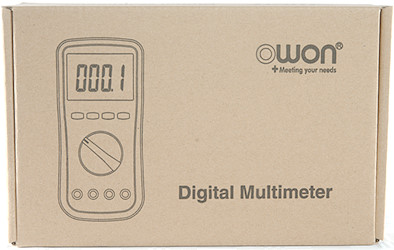
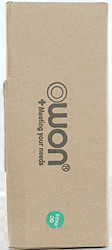
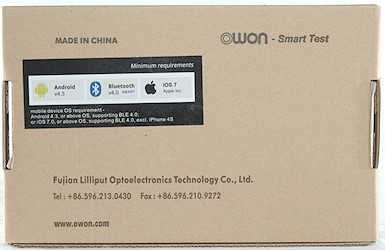
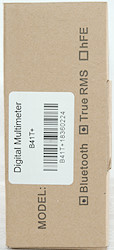
The meter arrived in a brown cardboard box with a minimum of text on it.
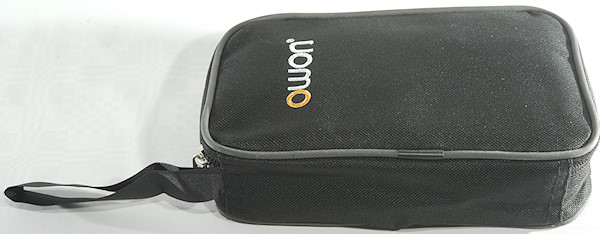
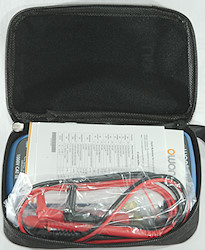
Inside was a pouch with everything in it.
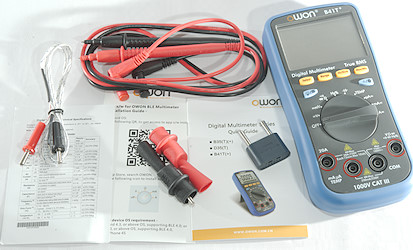
The box/pouch included the meter, probes, alligator clips, a thermocoupler, transistor tester adapter, pouch, quick guide, specifications, QR code for link to app.



Probes are marked 1000V 10A and the tip cover is marked CAT III, without the cover there is a CAT II marking.
The tip cover is screw on/off, the alligator clips are also screw on/off.
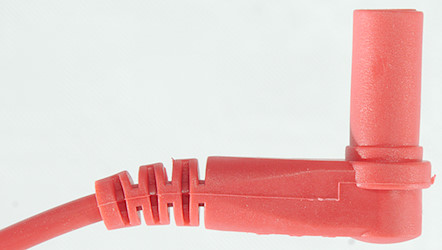
The plugs are fully shroud, but a bit on the short side.
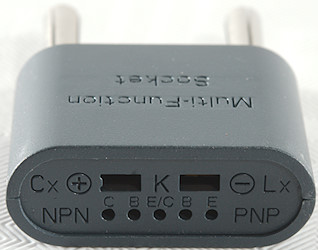
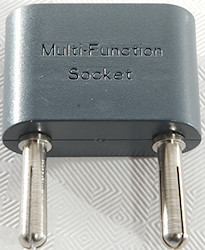
The transistor tester, thermocoupler, capacitor adapter. This way the transistor tester is safe, but only thermocoupler and capacitor adapter is used on this meter.


A cheap thermocoupler with banana plugs.
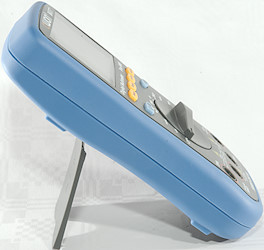
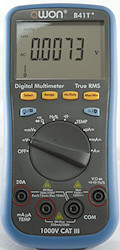
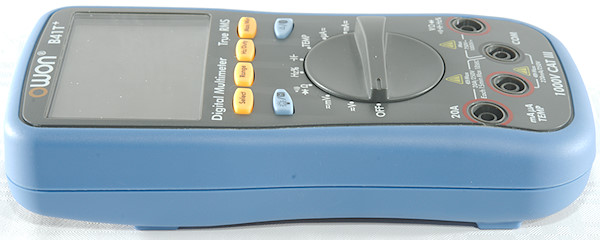
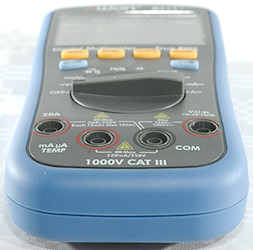

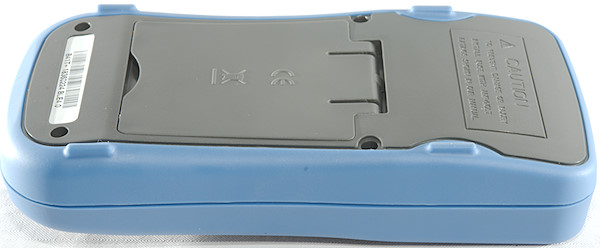

I do not like the plastic for the battery lid, I have the feeling that it is a hard plastic that easily breaks.
Display

The above picture shows all the segments on the display.

Normal DC voltage with voltage and bargraph.
Functions
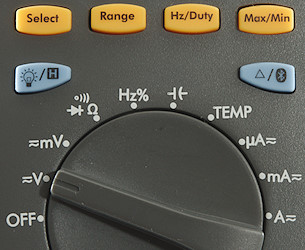
Buttons:
- Select: Select between DC and AC and modes in the ohm position.
- Range: Switch to manual range and select range, hold down to activate automatic ranging again.
- Hz/Duty: Select frequency and duty cycle in V and A modes.
- Max/min: Capture maximum and minimum values, press to display one or the other, hold down to exit mode.
 : Press to freeze/unfreeze current reading, hold down to turn on background light,
: Press to freeze/unfreeze current reading, hold down to turn on background light,
 : Press to use relative mode (REL), hold down to enable/disable Bluetooth.
: Press to use relative mode (REL), hold down to enable/disable Bluetooth.
REL and Max/min disables auto range.
Rotary switch:
- Off: Meter is turned off.
- V: Measure DC and AC voltage, DC includes a mV range, in AC it is possible to select frequency.
- mV: Millivolt range, has two mV ranges for both DC and AC, in AC it is possible to select frequency.
 : Resistance, continuity and diode
: Resistance, continuity and diode
- Hz%: Frequency, this support up to 60MHz.
 : Capacitance
: Capacitance
- Temp: Temperature.
- uA: The uA range.
- mA: The mA range.
- A: The A range.
There is no switch to activate logging, this must be done with the Bluetooth interface.
Input
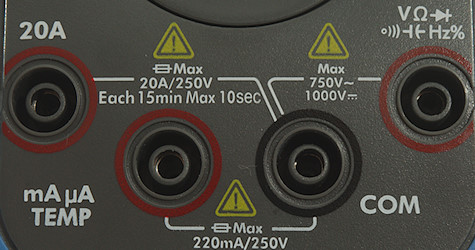
- A: High current, maximum current is 20A
- mAuA: The lower current ranges and input for thermocoupler
- CON: The common terminal for all ranges.
- xxx: All other ranges.
Measurements
- Volt and frequency
- Frequency input can handle a DC offset of +/-1.2V with 0.2Vrms input, but needs a few seconds to adjust.
- At 100mVrms frequency input range is from 2.1Hz to 800kHz
- At 1Vrms frequency input range is from 2.1Hz to 62MHz
- At 100mVrms AC input frequency range is from 2.1Hz to 150kHz
- Duty cycle works from 5% to 95% at 100kHz with 1Vpp, precision is within 6.0 (Due to the offset adjustment the readout takes some seconds to be stable)
- Duty cycle works from 5% to 95% at 100kHz with 2Vpp, precision is within 4.0 (Due to the offset adjustment the readout takes some seconds to be stable).
- 1 VAC is 5% up at 110kHz (RMS will not work at the frequency).
- Max/min needs about 330ms to capture a voltage.
- Input impedance is 10-11Mohm on DC and AC
- mV has 10Mohm input impedance up to about 3V, then it drops to 200kOhm at 5 Volt and 2kOhm at 20 volt.
- There is an audible warning when voltage is too high on any V range, but not on mV range.
- Frequency input is 10Mohm up to 1 volt then it drops to 1kohm at 5 volt
- Rated overload protection on V is 1000VDC / 750VAC
- Rated overload protection on mV and Hz is 250VDC or equivalent AC
- Current
- Meter has audible alarm with too high current in uA, mA and A range
- Overload protection in uA and mA: 1A/250V 5x20mm glass fuse
- Overload protection in A: 20A/250V 5x20mm ceramic fuse
- Measuring above 10A must only be performed for a short time.
- Ohm, continuity, diode and capacitance
- Ohm needs about 1.0s to measure 100ohm
- Ohm is -0.39V open and -0.34mA shorted
- Continuity is very fast (3ms).
- Continuity beeps when resistance is below 30ohm
- Continuity is -3.13V open and -1.8mA shorted
- Diode range uses 2.8V, max. display is 1.9V at 0.64mA, max. current is 1.9mA shorted
- 10uF takes about 0.8 second to measure.
- 70000uF takes about 13 seconds to measure.
- Rated overload protection is 250VDC or equivalent AC
- Miscellaneous
- Current consumption of meter is 3.5mA in Hz, 4.3mA in DC 5.4mA AC (16mA with backlight, 13.3mA with Bluetooth and 24mA with both).
- Meter works down to 1.5V where it turns off, battery symbol show at 2.3V.
- The meter reading is stable within a few count (About 10) down to the meter turns off.
- Backlight fades with voltage and is very dim at 2.5V
- Bluetooth works down to 1.6V
- Bluetooth disconnects fast when outside range.
- Local logging is done on the Bluetooth transceiver, this means it must be controlled from a phone.
- The meter usual needs two updates before reading is correct.
- Viewing angle is limited both from the top and the bottom.
- Display updates around 2 times/sec.
- Bargraph updates 30 times/sec
- Backlight will turn off in 57 seconds
- Will automatic turn power off in about 30 minutes
- Standard probes cannot be fully inserted into sockets on meter, but make connection, banana plugs can be fully inserted.
- Weight is 335g without accessories, but with batteries.
- Size is 185 x 88 x 45mm.
- Probes
- Probe resistance 31mOhm for one.
- Probe wire is soft and 87cm long.

A look at the capacitance measurement waveform, measuring 1uF.

Frequency input resistance.

Input impedance on mV range.

Battery time is without Bluetooth, with Bluetooth it is around 200 hours.
Software Android
The Bluetooth phone software must be downloaded from Owon site and requires access to phone information, contacts, location and storage. I disabled the phone and contact access and the application still works.
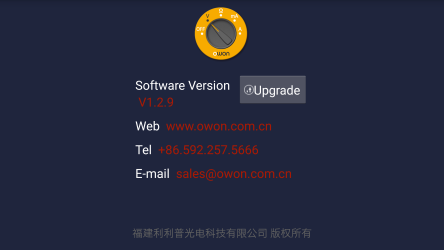
The software I got was V1.2.9 and I downloaded the Bluetooth 4 version. The program is called "MultimeterBLE" on Android.
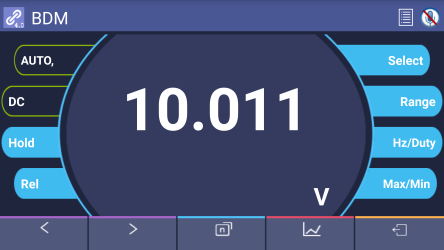
The typical meter display, the blue fields will activate buttons on the meter (it is still possible to use the button on the meter).
The microphone will enable English voice annotations of the value, the language is not perfect but understandable. The menu besides the microphone is used for meters with internal logging.
The software will only work in landscape mode.
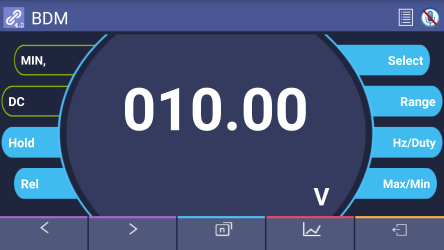
Here max/min has been activates, it is shown, but could have been more obvious.
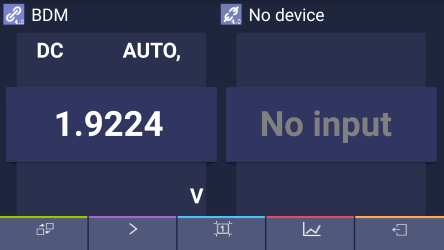
The software can support more than one meter, I only had one meter and have not tried this function.
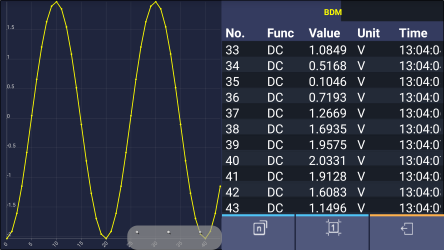
The logging mode, it shows a curve and a table, this data is also collected when showing the other display.
The chart has some problems: It do not change scale between mV and V, i.e. 600mV is shown as 600 and 2V is shown as 2 on the chart, this can occur in the same chart! This means it may be necessary to use the RANGE switch to get consistent charts.
I did not find a way to stretch the chart or table to full screen width. The chart and table will not reset if the range switch is turned, it will just continue to add data.
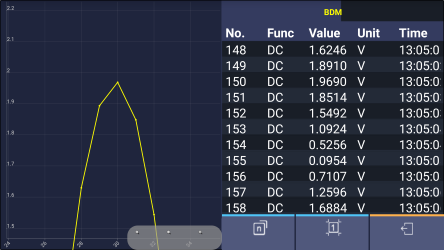
It is possible to zoom in/out on the curve, either with the buttons in the gray area or with two fingers.
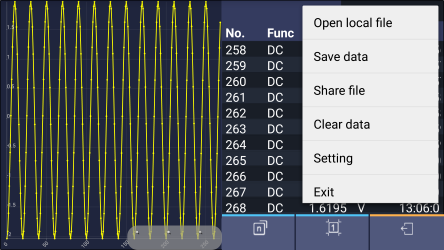
On this screen the menu has function to save the data and share the saved data. I shared it with an email program and received the email on my PC.
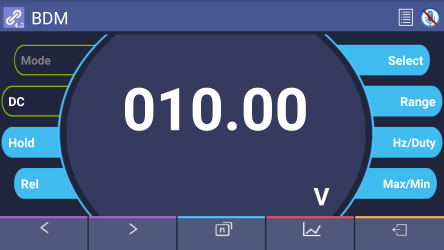
The settings can be used to adjust the sample interval and to set a time limit on how long to record the data. The "Fill" option will add a blue shading below the curve.

The data is saved in a csv/TAB file using US format and without any headers, this means I cannot directly import it into Excel (I need to specify format each time).
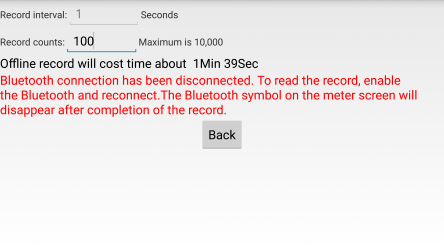
The offline record mode must be started from a phone, it cannot be started on the meter. When recording Bluetooth is disabled, but the Bluetooth symbol is used as record symbol on the meter.
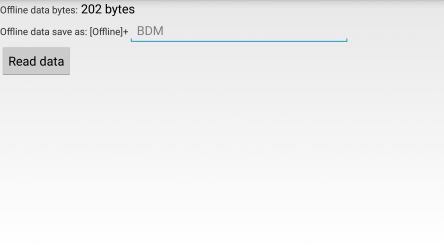
When the recording is finished Bluetooth can be enabled again on the meter and the phone can be connect for download.
Tear down

Before I open the meter the batteries must be removed, to open the meter there is four small screws.
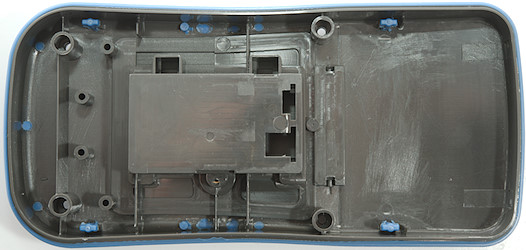
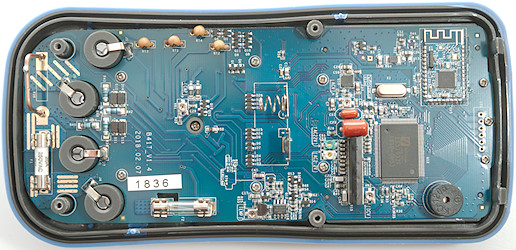
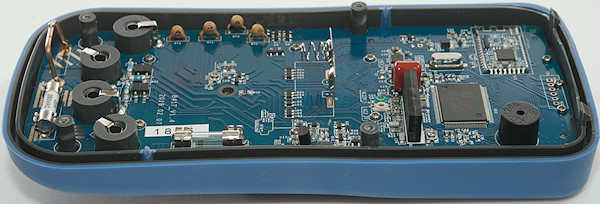
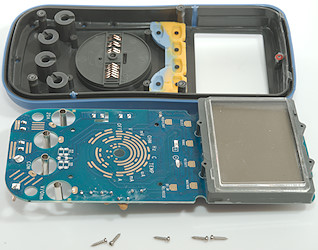
I had to remove five screws before I could take the circuit board out.
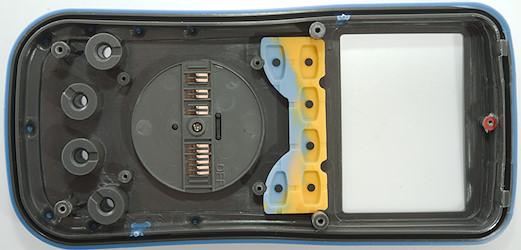
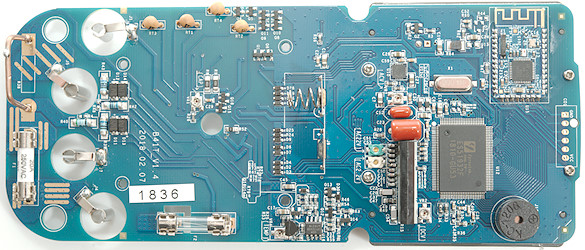
The current input uses four shunt resistors, for uA it is R43 (900ohm) with diodes in parallel and R42 (90ohm), for mA it is R39 (9ohm) with diodes in parallel and R40 (1ohm), this configuration gives a fairly high burden voltage, the protection is a 1A glass fuse, but it will not protect the R42 in the uA range and is fairly bad protection for R40. The voltage input only has PTC's, not MOV's this means high transient voltage may damage the meter.
The voltage input uses a "Black Box" resistor (R15) with capacitors (Include trim capacitors) for AC compensation. For ohm and capacity there is dual PTC's and transistor pairs (RT4 with Q4 & Q5, RT1 with Q15 & Q16), mV has a single PTC and transistor pair (RT3 with Q1 & Q6) and HZ also has a single PTC and dual transistor pair (RT2 Q8, Q9 Q10, Q11). The TEMP input do not have a PTC but goes directly to a transistor (Q1 near the reference). There is a lot of trimpots for adjusting the meters and they are labelled with range (Note AC22V & AC2.2V is capacitors and for high frequency response).
The main multimeter IC (U12: ES51932: 22000 count DMM chip) is a single chip, but with external RMS converter (U10: AD8439: RMS converter). The Bluetooth interface is a module (U15/U1: CC2541) with its own programmable processor, this is also the secret behind the off-line data collection, it is handled by this module, not by the multimeter.
For the input, there is a OpAmp (U16: SGMOP17C) next to a reference (U14: LM385B: Reference 1.2V). The large collection of diodes (D2, D3, D4, D6, D7, D9, D24, D25, D26, D27, D28, D29) is probably encoding of the rotary switch for the multimeter chip.
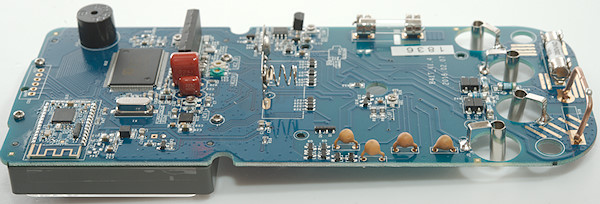
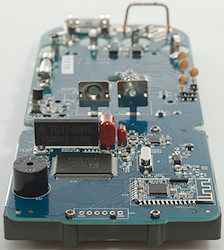

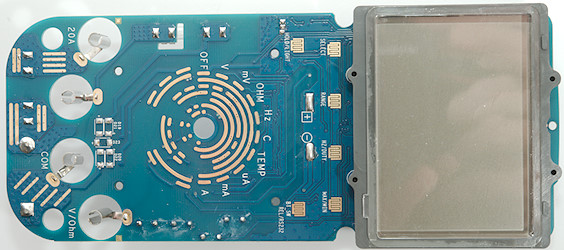
There is space for a diode bridge (D19..D23) to protect the uAmA shunt resistors, but it is not mounted, it would probably affect the ranges too much.
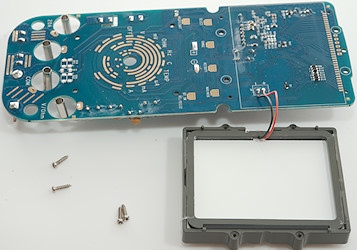
The LCD display is mounted with four screws.

There is hidden a couple of resistors, capacitors, diodes and a single transistor under the display.

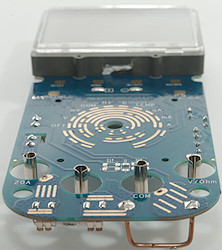
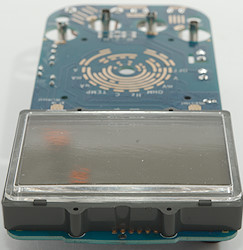

Conclusion
The CAT rating cannot be correct with 250V fuses.
The meter has a nice collection of ranges and good resolution, but the burden voltage is high, the high uA and mA is rather bad. The off-line logging must be controlled from a phone, it cannot be initiated on the meter.
Except for some current ranges it is a good multimeter.
Notes
How do I review a DMM
More DMM reviews
Multimeter design, this explains a lot more about DMM's than my tear-downs
 : Press to freeze/unfreeze current reading, hold down to turn on background light,
: Press to freeze/unfreeze current reading, hold down to turn on background light,
 : Press to use relative mode (REL), hold down to enable/disable Bluetooth.
: Press to use relative mode (REL), hold down to enable/disable Bluetooth.


























 : Press to freeze/unfreeze current reading, hold down to turn on background light,
: Press to freeze/unfreeze current reading, hold down to turn on background light,
 : Press to use relative mode (REL), hold down to enable/disable Bluetooth.
: Press to use relative mode (REL), hold down to enable/disable Bluetooth.
 : Resistance, continuity and diode
: Resistance, continuity and diode
 : Capacitance
: Capacitance
































